Analysis: The one passage of play that sums up the difference between the All Blacks and Wallabies

Another year, another lost Bledisloe campaign.
The Wallabies continue to look for answers after a 40-13 drubbing at the hands of the All Blacks at Eden Park last night. The problems were varied, although the lineout and scrum was far better this time around. They were killed on turnover ball once again, as the All Blacks ran wild in transition phases.
While many are quick to jump and defend Michael Cheika and his coaching staff, there are visible and clear issues with their attacking play that proves to be ineffective.
The Wallabies run complex pre-set attacking waves from set-piece that can last up to five phases or more – it looks fancy but ends up doing next to nothing. There is a lot of pre-planned player movement, but a lack of substance makes it very easy to defend.
The automated, rigid nature of the telegraphed plays they run don’t challenge the defence and the passing is too deep to deceive anyone – as soon as one player throws the ball back deep to the next, the defence can just slide and swallow up the runner, often behind the gain line.
Pressure never builds enough to break down the defence, and inversely it’s the Wallabies who lose any semblance of shape by running scripted play after play without getting into a balanced pattern.
Nothing illustrates this better than the passage of play at a pivotal moment, right before halftime from a Wallabies attacking lineout.
On the first play, they run Dane Haylett-Petty on a cut after a screen pass from Bernard Foley to Kurtley Beale. The first thing to process is the depth the players receive the ball from.
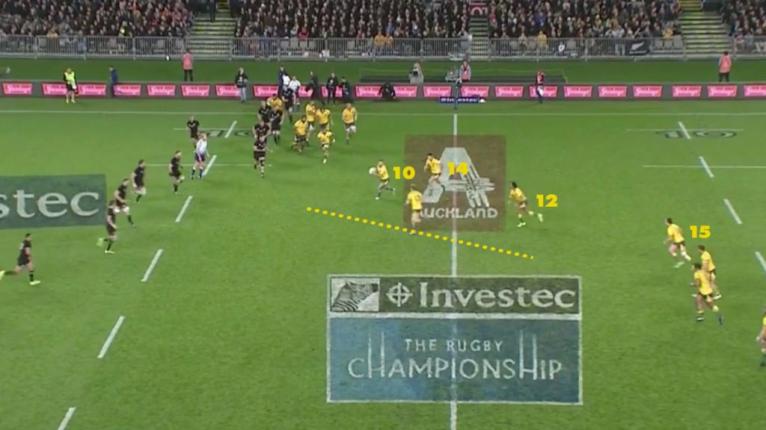
 Beale feeds Haylett-Petty underneath without challenging any All Blacks defenders. Reece Hodge, who ran a dummy line, hasn’t reached the defensive line yet which begs the question, what was the point of his angle and line? No defenders are drawn into contact. He hasn’t created any indecision at all, and might as well have stood still on the play to conserve energy.
Beale feeds Haylett-Petty underneath without challenging any All Blacks defenders. Reece Hodge, who ran a dummy line, hasn’t reached the defensive line yet which begs the question, what was the point of his angle and line? No defenders are drawn into contact. He hasn’t created any indecision at all, and might as well have stood still on the play to conserve energy.
Beale releases the ball back inside, still metres from the defensive line and all the All Blacks have to to do is make a front-on tackle on Haylett-Petty. The Wallabies progress through the move with unnecessary complexity when a simple midfield crash would yield the same result.
The next phase sees the first forward runners coming around the corner. Adam Coleman is coming from a depth of nearly 8.5 metres to take a carry, whilst Foley, Beale and Michael Hooper wait even deeper for a scripted third phase play.
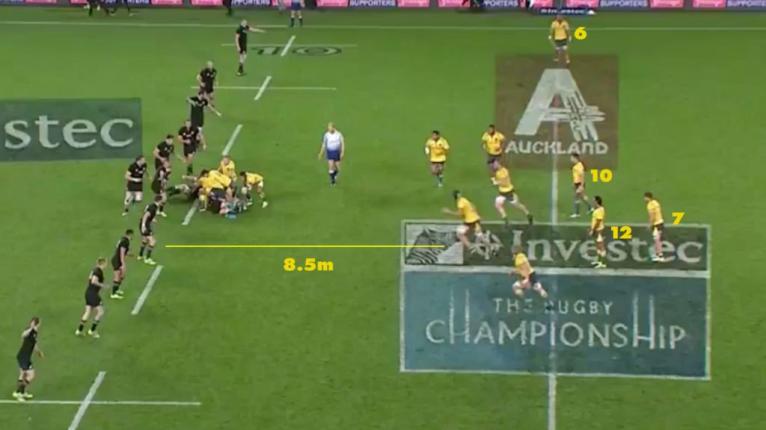
Lukhan Tui stands alone on the wing on the far side, with half a field between him and the next player. If Coleman spills the ball in contact, the All Blacks could theoretically move the ball left to attack this space and catch the Wallabies struggling to cover.
Just on that picture alone, you can see why the All Blacks are scoring a ton of points from turnover ball against them. These elaborate pre-planned plays after multiple phases offer vast areas of space to attack.
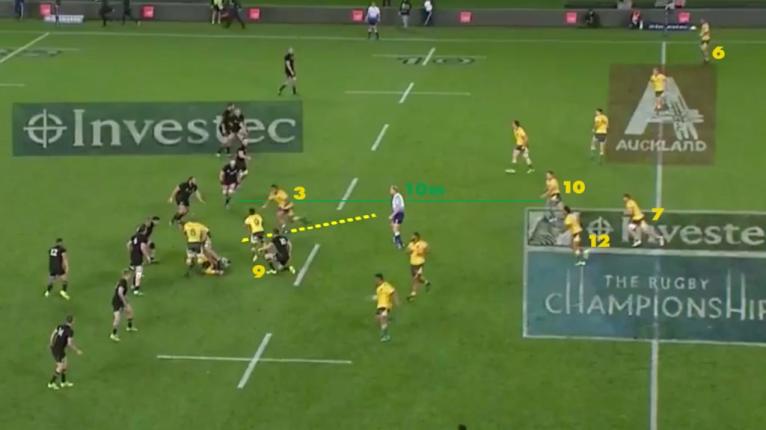
On the next phase Will Genia picks up the ball and has a short runner in close with Alaalatoa (3), but his backdoor option Foley is extremely deep. He is at least 10 metres away from the defensive line.
The defender has enough time to cover Alaalatoa, realise he’s not getting the ball and then slide back to cover Foley out the back. It’s really easy pickings.
Genia’s pass has to be deep to reach Foley, and the All Blacks defence will have plenty of time to process his inside runners, Beale and Hooper. Space is actually developing on the edge, but the Wallabies go through the motions of their multi-phase set play and Foley tries to attack the line.
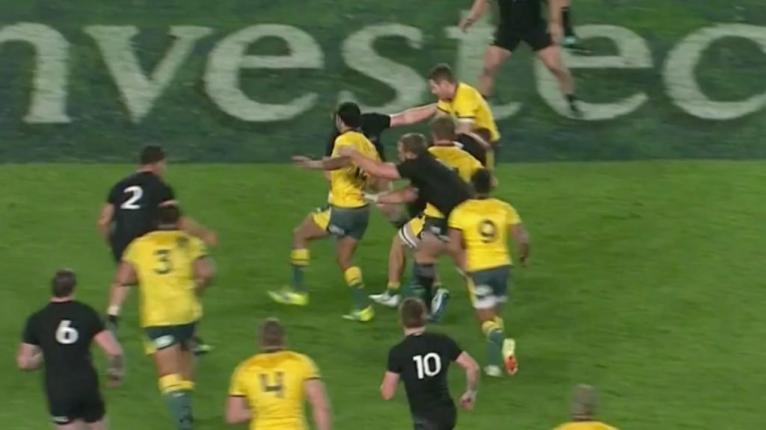
Recieiving from such depth, Foley is an easy target and is hammered by Sam Cane as Hooper and Beale end up in a tangled mess. He retains possession and the Wallabies move to the edge with Tui to start a new pattern.
The same issues persist in every play – the depth of passing and the failure to challenge the All Blacks defence with legitimate running options. The final runner has the ball so early the Wallabies have done the All Blacks’ work for them – they don’t even need to read what player to tackle.
This has either been instructed by coaches, been failed to be identified by coaches as a problem, or it has been talked about and the players are unable to correct it. It is likely to be one of the first two reasons because when players don’t do what the coaches tell them, they usually get replaced by someone who does.
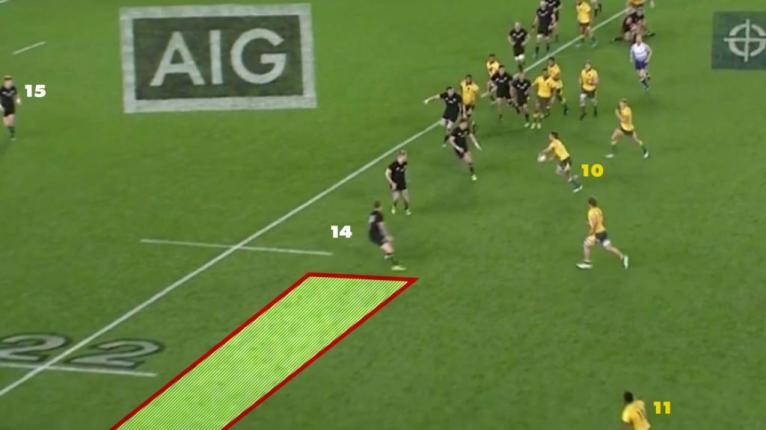
In the same possession but a few phases later, Foley again runs a scripted inside ball to Hodge, releasing the pass without committing a defender. He is going through the motions of the planned play and doesn’t even think to fire a long ball out to the unmarked Marika Koroibete, where the space is.
After eight phases, the Wallabies have made good metres but have mustered a whole lot of nothing, tiring themselves out with ridiculous running from deep. On the next phase, Beale coughs the ball up and this happens one phase later.
Simple draw and pass skills and moving the ball to the space. It’s a planned strategy to attack off turnover ball, but more of a framework to operate within. The players can play what’s in front of them and make their own decisions.
The Wallabies tire themselves out with unnecessary, poorly designed play, turn the ball over and the All Blacks beat them with simple skills (draw and pass) and principles (attack space).






































Comments on RugbyPass
The game was a quarter final, not a semi final. Barrett will be here for 6 months, he is no one's replacement at 13. That mantle will most likely ultimately go to Jamie Osborne, though Garry Ringrose has at least 4 more years in him. The long term problem position (in the next 3 years) for Leinster is tighthead prop, though there are a couple of prospects at schools level.
21 Go to commentsSo much for all that hype surrounding the ‘revival’ of Aussie rugby. The Blues were without the likes of regular starters Perofeta, Sullivan, Christie etc… This was a capitulation of the highest order by Australia’s finest. Joe Schmidt definitely has his work cut out for him.
2 Go to commentsYes they can ignore Sotutu. Like Akira Ioane plays OK at Super level but gets lost in tests. Too many chances too many failures.
2 Go to commentsA wallaby front-row of Bell, Blake and Tupou…now that would be hefty
1 Go to comments“But with an exceptional pass accuracy rating “ Which apart from Roigard is not a feature of any of the other 9s in NZ. Kind of basic for a Black 9 dont.you. think? Yet we keep seeing FC and TJ being rated ahead of him? Weird if it’s seen as vital to get our backline beating in your face defences.
1 Go to commentsThanks BeeMc! Looks like many teams need extra time to settle from the quadrennial northern migration. I think generally the quality of the Rugby has held up. Fiji has been fantastic and fun to watch
13 Go to commentsLets compare apples with apples. Lyon sent weak team the week before, but nobody raised an eyebrow. Give the South African teams a few years to build their depth, then you will be moaning that the teams are too strong.
41 Go to commentsDid footballs agents also perform the scout role at some time? I’m surprised more high profile players haven’t taken up the occupation, great way to remain in the game and use all that experience without really requiring a lot of specific expertise?
1 Go to commentsSuper rugby is struggling but that has little to do with sabbaticals. 1. Too many teams from Aust and NZ - should be 3 and 4 respectively, add in 2 from Japan, 1 possibly 2 from Argentina. 2. Inconsistent and poor refereeing, admittedly not restricted to Super rugby. Only one team was reffed at the breakdown in Reds v H’Landers match. Scrum penalty awarded in Canes v Drua when No 8 had the ball in the open with little defence nearby - ideal opportunity to play advantage. Coming back to Reds match - same scrum situation but ref played advantage - Landers made 10 yards and were penalised at the breakdown when the ref should have returned to scrum penalty. 3. Marketing is weak and losing ground to AFL and NRL. Playing 2 days compared with 4. 4. Scheduling is unattractive to family attendance. Have any franchises heard of Sundays 2pm?
12 Go to commentsAbsolutely..all they need is a chance in yhe playoffs and I bet all the other teams will be nervous…THEY KNOW HOW TO WIN IM THE PLAYOFFS..
2 Go to commentsI really hope he comes back and helps out with some coaching.
1 Go to commentsI think we are all just hoping that the Olympic 7s doesn’t suffer the same sad fate as the last RWC with the officials ruining the spectacle.
1 Go to commentsPersonally, I’ve lost the will to even be bothered about the RFU, the structure, the participants. It’s all a sham. I now simply enjoy getting a group of friends together to go and watch a few games a year in different locations (including Europe, the championship, etc). I feel extremely sorry for the real fans of these clubs who are constantly ignored by the RFU and other administrators. I feel especially sorry for the fans of clubs in the Championship who have had considerable central funding stripped away and are then expected to just take whatever the RFU put to them. Its all a sham, especially if the failed clubs are allowed to return.
10 Go to commentsI’m guessing Carl Hayman would have preferred to have stayed in NZ with benefit of hindsight. Up north there is the expectation to play twice as many games with far less ‘player management’ protocols that Paul is now criticising. Less playing through concussions means longer, healthier, careers. Carter used as the eg here by Paul, his sabbatical allowed him to play until age 37. OK its not an exact science but there is far more expectations on players who sign for Top 14 or Engl Prem clubs to get value for the huge salaries. NZR get alot wrong but keeping their best players in NZ rugby is not one of them. SA clubs are virtually devoid of their top players now, no thanks. They cant threaten the big teams in the Champions Cup, the squads have little depth. Cant see Canes/Chiefs struggling. Super has been great this year, fantastic high skill matches. Drua a fantastic addition and Jaguares will add another quality team eventually. Aus teams performing strongly and no doubt will benefit with the incentive of a Lions tour and a home RWC. Let Jordie enjoy his time with Leinster, it will allow the opportunity for another player to emerge at Canes in his absence.
12 Go to commentsLove that man, his way to despise angry little men is so funny ! 😂
5 Go to comments“South African franchises would be powerhouses if we had all our overseas based players back in situ. We would have the same unbeatable aura the Toulouses, Leinsters or Saracens of this world have had over the last decade or so.” Proof that Jake white does not understand the economics of the game in SA. Players earning abroad are not going to simply come back and represent the bulls. But they might if they have a springbok contract.
25 Go to commentsA lot of fans just joined in for the fun of it! We all admire O'Gara and what he has done for La Rochelle
5 Go to commentsThe RFU will find a way to mess this up as usual. My bet is there will be no promotion into the the Premiership, only relegation into National League One. Hopefully they won’t parachute failed clubs into the league at the expense of clubs who have battled for promotion.
10 Go to commentsWell that’s the contracts for RG and Jordie bought and paid for. Now, what are the chances we can persuade Antoine to hop over with all the extra dosh we’ll have from living at the Aviva & Croke next season…??? 🤑🤑🤑
37 Go to commentsWow, that’s incredible. Great for rugby.
37 Go to comments